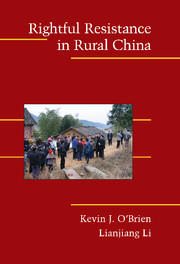Book contents
Appendix B - Sources
Published online by Cambridge University Press: 05 September 2012
Summary
Survey Samplings
Our 1999 survey was administered by eighty-seven university students in their home villages, which were located in eighty-two counties, twenty-five provinces. In each village, the interviewer drew a simple random sample of 10 percent of adults between eighteen and seventy years of age from the “village small group” (cunmin xiaozu) that his or her family belonged to. Altogether 1,384 villagers were interviewed.
The 1999–2001 survey was conducted in two counties in Jiangxi province, one county in Jiangsu province, and one county in Fujian province. The four counties were selected because our associates had good working relations with local leaders and could sample and interview rural residents without restriction. Sampling in each county was conducted in three stages. First, five townships were selected. Second, four administrative villages were selected from each township. Samples of townships and villages were based on the principle of probabilities proportionate to size such that all townships in a county and all villages in a township had equal probability of being chosen regardless of population. Within each village, a simple random sample of 40 individuals older than the age of eighteen was drawn based on household registration records. The sample was then randomly divided into a base group and a backup group. If a selected villager in the base group was not available or turned down a request to be interviewed, then a villager with a similar demographic background in the backup group was approached.
- Type
- Chapter
- Information
- Rightful Resistance in Rural China , pp. 139 - 142Publisher: Cambridge University PressPrint publication year: 2006

